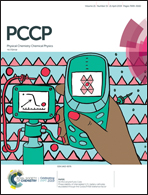Hydrogen storage mechanism and diffusion in metal–organic frameworks
Abstract
Diffusion and storage of hydrogen molecules in metal–organic frameworks are crucial for the development of next-generation energy storage devices. By resorting to the first principles modeling, we compute the diffusion coefficient of molecular hydrogen in these systems in a range of temperatures where MOF-based devices are expected to operate. The explicit inclusion of the electronic structure shows that diffusivities are one order of magnitude smaller than those reported by classical simulations, evidencing the insufficiency of the empirical force fields used so far. We show that hydrogen is mainly rolled up around the metal oxide nodes both in MOF-5 and IRMOF-6, and partly around the carbon atoms in the case of IRMOF-6, where charged linkers are present. Metal ions embedded in the junction sites exert an electrostatic attraction toward hydrogen and the resulting distribution shows some ordering around these same sites at low temperature, whereas this tendency vanishes at room temperature. The induced polarization of hydrogen molecules generates an electrostatic interaction with charged atoms inside these nano-scaffolds and this is a key factor for the enhancement in hydrogen storage both in MOF-5 and IRMOF-6. The mechanism discussed hereby provides a novel understanding of metal–organic frameworks and acts as a guide to tune their efficiency for hydrogen storage. Moreover it paves the way to a computer-aided design of effective MOFs indicating that a fine control of the distribution of electrostatic charges inside the hydrogen hosting structure is crucial.



 Please wait while we load your content...
Please wait while we load your content...